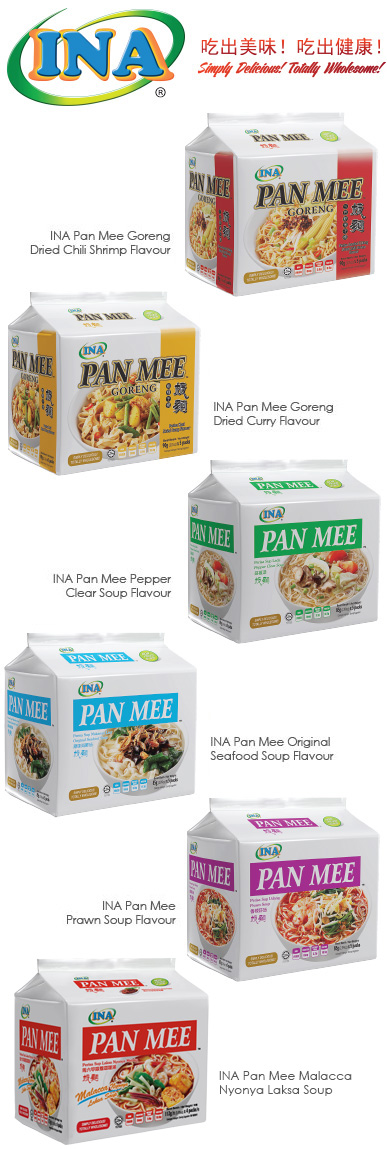Pan Mee,also pronounces as Ban Mian in Chinese. The place of origin is in Taihe County, Province of Anhui in China, Pan Mee has survived since the era of Three Kingdoms in ancient China history and has since becomes a delicacies amongst the Chinese. If you visited Taihe County in China, you can find hundreds of various sizes of shop and stall selling Pan Mee.
The traditional way of Pan Mee making is kneads noodle dough by hand, the process of kneading, pulling, stretching and hitting the dough on the table makes the noodle chewier and the sound of the dough hitting the table gives the name of Pan Mee.
Pan Mee was originally called “Flat Flour Noodle” in Malaysia; it was a local Hakka cuisine during the Golden Days and was widely accepted as a delicacies noodle amongst Hakka community.
After years of consolidation of local Chinese foods in Malaysia, Pan Mee is no more the sole delicacies of Hakka community as it is widely accepted by all Chinese nowadays. You can find Pan Mee not only at home, food stall, hawker centre, but also in Restaurant, Pan Mee specialty shop and even franchise shops.
Pan Mee is typically served in soup or thick black soy sauce (dried pan mee). The soup is boiled from dried anchovies. Both types of serving are topped with fried dried anchovies, minced meat, sliced mushroom, fried onions and a leafy vegetable called “sayur manis” (sauropus androgynus). To cater for the various appetite of its lover, Pan Mee is not only served in soup and thick black soy sauce. You can easily find Pan Mee served with Curry flavored soup, Pepper Clear flavored soup, Prawn flavored soup and Seafood flavored soup. If you are lucky enough, you can even find food stall selling fried Pan Mee as their signature dish. The topping of Pan Mee has also varied from the original toppings to toppings like meat, meat balls, fish balls, fish cakes and various kind of vegetable.
In order to cater for the high demand, Pan Mee is no more a handmade noodle and instead it is replaced with mass production by noodle making machine. The machine production not only reduces the dependent on handmade noodle master which is comparatively lesser due to retirement but also due to hygienic reason. As time is always of essence in our currently living style, instant noodle emerges to be an important and time saving food nowadays. In such a competitive market environment, INA PAN MEE has marketed before others assorted flavors of instant noodle Pan Mee to cater the need of its lover.
At last, we can conclude that Pan Mee has evolved from its place of origin in China and has becomes a local delicacies in Malaysia in terms of the types of serving as well as the toppings. Pan Mee has also been introduced to other races in Malaysia and is now widely accepted amongst the local community here.


板麺的起源可以追溯到三国时期,它的发源地是在中国安徽省太和县,在太和县买板麺的馆子不下数百家,堪称是板麺馆之最。
板麺之名又从何而来呢?据说早期制作板麺的厨师为了使麺条更有嚼劲,将麺棒用双手不停的摔在案子上而发出声响,板麺因此而得其名。
那在马来西亚本土的板麺和太和县的板麺又有什么不同之处呢?马来西亚的板麺也被称为“麺粉糕”,在早期是客家人独有的美食,所以早期板麺在客家社群是一道很普遍的美食。而麺条的制作也只以普通的麺粉,鸡蛋和水以纯手工搓擀而成。而在经过了数十年华人美食的整合,板麺已经不再是客家人独有的美食。板麺的出现可以小至家里,路边摊,美食中心,而大至餐馆,专卖店甚至连锁经营。
马来西亚早期的板麺只有干捞和清汤麺两种选择,汤头也只以江鱼仔来熬成。而配料也只以普通的切片香菇,肉燥,树子菜,炸脆江鱼仔和红葱酥配搭。为了迎合食客的需求,现今的板麺除了干捞和清汤两种选择之外,也推出了各种不同口味的汤头如加哩汤,胡椒汤,虾汤,海鲜汤等等。有者甚至于用炒板麺来当自己的生招牌。而现今的配料也加入了比较可以迎合大众口味的肉类,肉丸,鱼丸,鱼饼以及一般的青菜。
现今为了应付庞大的需求量,板麺出产商已经用机械化生产来代替手工制作,这不但符合卫生标准,也能减低对制麺师傅的依赖以及在短时间内大量生产以应付需求。在现今时间短促的社会里,即食麺对于打工一族来说已经是不可或缺的食物,为了顾及板麺爱好者的需求,传统的板麺已经被改良成即食板麺。INA板麺也已在这竞争激烈的市场里首先推出了各种不同口味的即食板麺。
总括来说,马来西亚的板麺已经脱离了其在原乡的口味而自成一格,其口味也是属于真正道地的本土麺食。板麺也已经渐渐的融入了马来西亚多元种族的社群,其他族群也渐渐的喜欢上了这一道华社独有的麺食,而其多元化的口味也使其名堂在本土更加的发扬光大。
